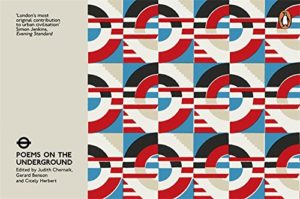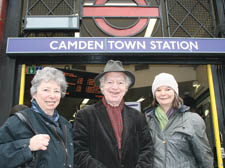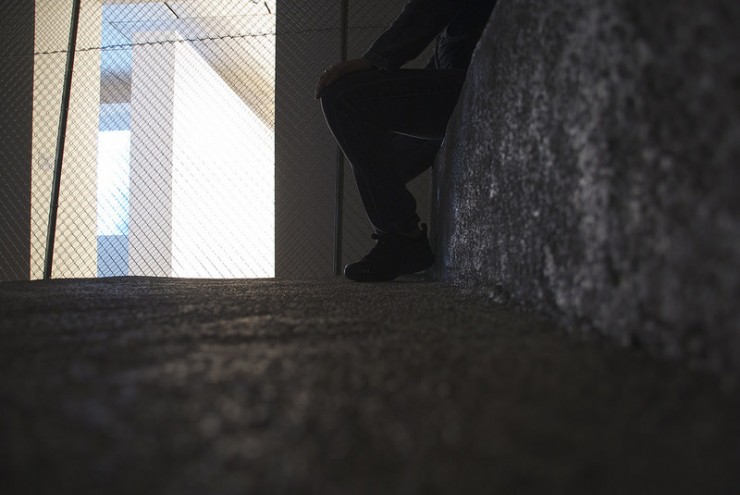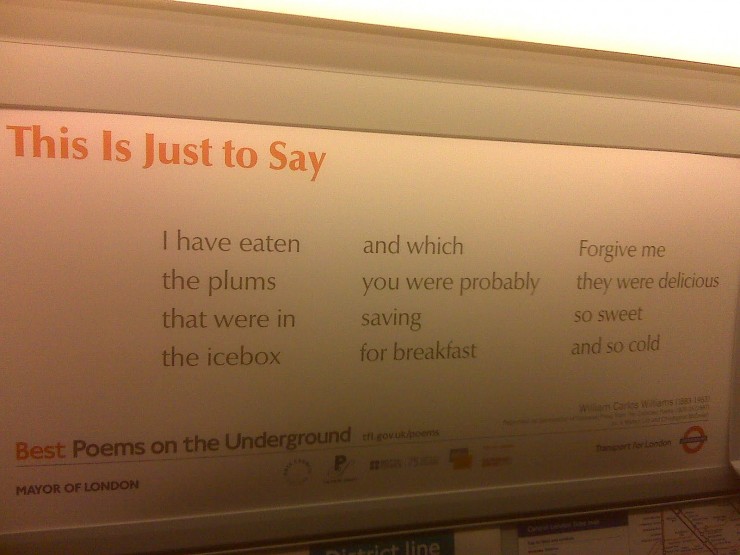You’re riding the underground, or Tube, in London. It’s morning rush hour. You’re holding on to an overhead bar with one hand while holding your briefcase with the other. Your body moves back and forth with the motion of the train. You avoid eye contact with other riders; eye contact and conversation with strangers simply isn’t done (and not just in London).
You listen to the official intercom voice announcing what station is next, and telling those departing the train to “mind the gap.” The doors close, the train jerks forward, and you do something you don’t normally do—you glance at the Tube map to see your progress toward your station. It’s in a line with various advertisements.
Right next to the Tube map, you see this:
Since 1986, riders on the Tube have been able to see that and dozens of other poems. It started as an experiment by three friends and lovers of poetry. They convinced London Underground to post a few poems on the trains, and the managers actually doubled the number of spaces allotted.

The three friends and poets served as the editors—Judith Chernaik (an American), Gerard Benson, and Cicely Herbert. (In the 2015 edition, Chernaik and Herbert noted that Benson died last year.) Rather than grouping the poems chronologically, the editors have assembled them into themes and categories: love; London; The Wider World; Exile and Loss; Seasons; The Natural World; Families; Out There; Dreams; Music; Sense and Nonsense; The Darker Side; War; The Artist as “Maker”; The Poet as Prophet; and Poetry: A Defense.

Judith Chernaik, Gerard Benson, and Cicely Herbert
And the poets represent a diverse, international lot—from Seamus Heaney and Derek Walcott to Emily Dickinson, William Blake, William Shakespeare, Wallace Stevens, William Carlos Williams, Elizabeth Bishop , Matsuo Basho, and many more, both well known and lesser known (noticeably missing from this collection is anything by T. S. Eliot, interestingly enough).
Despite the diversity of poets and themes, I find they do have something in common, other than relative brevity. They are chosen to make a reader think, perhaps smile or frown, but to think about what it said and what is meant. There’s a rather plaintive tone to these poems—selected, perhaps, to surprise riders and make them consider what the poem is saying, like this one by Sylvia Plath:
I can say that I have seen several of the poems firsthand on the Tube, during recent visits to London. The first time, my wife, knowing I generally don’t read ads, nudged me and motioned toward what at first looked like an ad but was instead a poem. I was enchanted, and began searching them out on various Tube rides.
Poems on the Underground is a delightful collection, reminding us that poetry is not only something that can be read, but also something that can be transported.
Related: Poetry for Life: Transport It – on Seattle Buses.
Photo by Geir Tonnessen, Creative Commons, via Flickr. Post by Glynn Young, author of the novels Dancing Priest and A Light Shining, and Poetry at Work.
__________________________

Photo by Donnie Nunley, Creative Commons, via Flickr. Post by Glynn Young, author of the novels Dancing Priest and A Light Shining, and Poetry at Work.
“I require all our incoming poetry students—in the MFA I direct—to buy and read this book.”
—Jeanetta Calhoun Mish
- Poets and Poems: Paul Pastor and “The Locust Years” - June 26, 2025
- What Happened to the Fireside Poets? - June 24, 2025
- “What the House Knows”: An Anthology by Diane Lockward - June 19, 2025



Jody Lee Collins says
What fun. Thank you for the ‘tour’, sir.
Glynn says
Thanks for reading the post, Jody!
Simply Darlene says
Ah, this piece seemed so familar, then I re-read your similar article about Seattle buses… in it you tell a wee little bit about the Tube’s poetry. Have you purchased one of the poem posters?
I wonder about the why
of purposeful words
on the walls – maybe one
stranger will spark
a grin – maybe another
stranger will mistake it
as meant for him, and
soonafter the rails may
rock with chatter, banter, even
rollick with friendly laughter.
Glynn says
Darlene – Last week, I went looking for a poster at the London Transport Museum, but there were none to be had (although they have a boatload of posters). I settled for a coffee cup with the tube map on it. 🙁
Thanks for sharing the poem!
louise gallagher says
Love the poems — and yes, they are enchanting!
I too like the journey you’re taking us on!
Sandra Heska King says
I need to visit London… if only for the poetry.
Louise Etheridge says
I started my first job in London in 1986: new to the city, fumbling my way around the underground. Everything was weird and new and detailed and strange. I remember Poems on the Underground vividly, thinking how cool it was and not realising it was a new initiative. The poem that stood out for me, and still does, was Derek Mahon’s Dog Days:
‘When you stop to consider
The days spent dreaming of a future
And say then, that was my life.’
For the days are long –
From the first milk van
To the last shout in the night,
An eternity. But the weeks go by
Like birds; and the years, the years
Fly past anti-clockwise
Like clock hands in a bar mirror.
It’s a pretty unnerving poem when I stop to consider what a procrastinator I am.
Thanks for the post, Glynn.
Glynn says
Great story (and poem), Louise. Thanks for sharing both!
Alan says
My mother brought back a copy from a trip to London and it’s become dog-eared
over the years from all the reading and underlining passages that resound with me. That poem has become one of my all-time favorites. I think of it and quote it often.